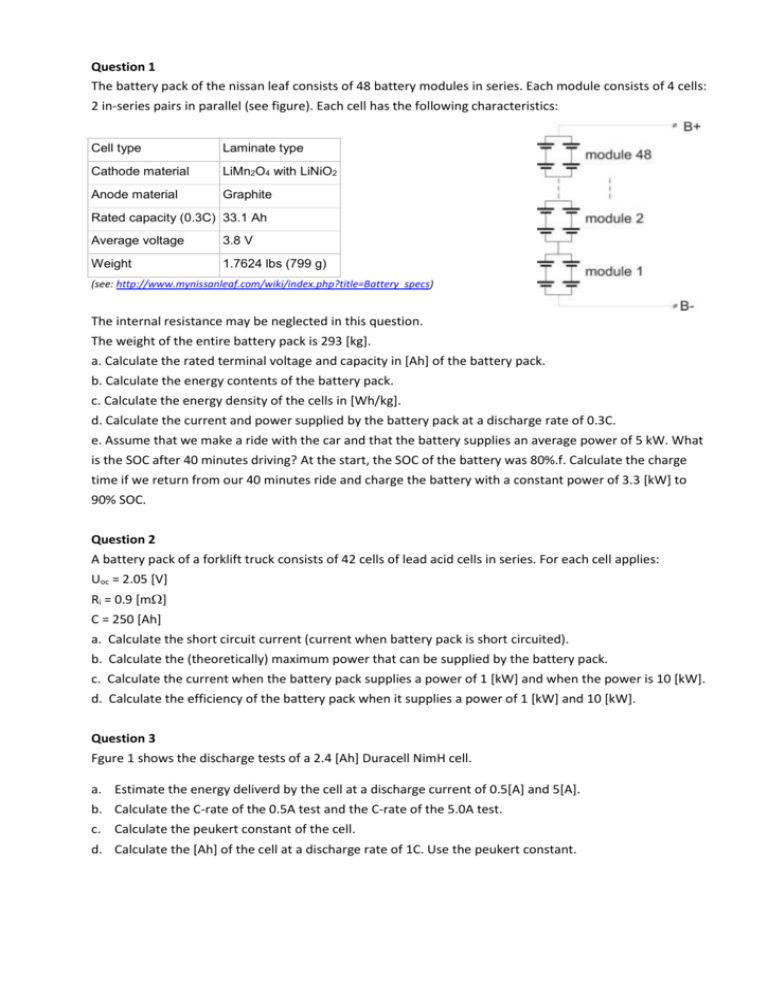Question 1 The battery pack of the nissan leaf consists of 48 battery
advertisement

Question 1 The battery pack of the nissan leaf consists of 48 battery modules in series. Each module consists of 4 cells: 2 in-series pairs in parallel (see figure). Each cell has the following characteristics: Cell type Laminate type Cathode material LiMn2O4 with LiNiO2 Anode material Graphite Rated capacity (0.3C) 33.1 Ah Average voltage 3.8 V Weight 1.7624 lbs (799 g) (see: http://www.mynissanleaf.com/wiki/index.php?title=Battery_specs) The internal resistance may be neglected in this question. The weight of the entire battery pack is 293 [kg]. a. Calculate the rated terminal voltage and capacity in [Ah] of the battery pack. b. Calculate the energy contents of the battery pack. c. Calculate the energy density of the cells in [Wh/kg]. d. Calculate the current and power supplied by the battery pack at a discharge rate of 0.3C. e. Assume that we make a ride with the car and that the battery supplies an average power of 5 kW. What is the SOC after 40 minutes driving? At the start, the SOC of the battery was 80%.f. Calculate the charge time if we return from our 40 minutes ride and charge the battery with a constant power of 3.3 [kW] to 90% SOC. Question 2 A battery pack of a forklift truck consists of 42 cells of lead acid cells in series. For each cell applies: Uoc = 2.05 [V] Ri = 0.9 [m] C = 250 [Ah] a. Calculate the short circuit current (current when battery pack is short circuited). b. Calculate the (theoretically) maximum power that can be supplied by the battery pack. c. Calculate the current when the battery pack supplies a power of 1 [kW] and when the power is 10 [kW]. d. Calculate the efficiency of the battery pack when it supplies a power of 1 [kW] and 10 [kW]. Question 3 Fgure 1 shows the discharge tests of a 2.4 [Ah] Duracell NimH cell. a. Estimate the energy deliverd by the cell at a discharge current of 0.5[A] and 5[A]. b. Calculate the C-rate of the 0.5A test and the C-rate of the 5.0A test. c. Calculate the peukert constant of the cell. d. Calculate the [Ah] of the cell at a discharge rate of 1C. Use the peukert constant. Figure 1: discharge tests of a NiMH-cell (figure copied from: http://www.candlepowerforums.com/vb/showthread.php?79302-NiMh-Battery-Shoot-Out) Question 4 Figure 2 shows the most important specifications and discharge curves of a Sinopoly 100 [Ah] LiFePO4 cell. Figure 2: Discharge curve and specifications of a Sinopoly 100 [Ah] LiFePO4 cell. a. Determine the internal resistance of the cell from the discharge graphs at a SOC of 50%. b. Calculate the open terminal voltage and (theoretically) maximum power that can be supplied by the cell (SOC=50%). c. Calculate the maximum power that can be supplied by the cell if we don’t exceed the current given in the specifications. d. Calculate the energy- and power density of the cell. Use the maximum power calculated at question c for the power-density calculation. e. Calculate the power that is needed to charge the battery with the maximum charge current (SOC=50%). f. Calculate the selfdischarge current (the value in the table is the self-discharge rate per month). Question 5 The below shows a dynamic battery model and the open terminal voltage as a function of the SOC. The battery is loaded with a puls current of 150[A]. The puls starts at t=60s and ends at t=360s. The initial state of charge is 80%. The capacity of the battery is 40 [Ah]. a. Draw the SOC as a function of the time in the range 0 t 600s. b. Make a sketch of the terminal voltage as a function of the time in the range 0 t 600s. Question 6 The values below give the properties of 2000F supercap. rated voltage = 2.7 [V] internal resistance = 0.47 [m] mass = 0.32 [kg] selfdischarge current = 3.0 [mA] a. Calculate the energy density of the supercap. b. Calculate the power density of the supercap. c. Calculate the current and efficiency if the supercap is fully charged and is connected to a 500 [W] load. d. Calculate the voltage of a supercap one day after it is charged and not being loaded. Answers: 1a. U=48*2*3.8 = 365V, C=2*33.1 = 66.2[Ah] 1b. W=U*C = 24.1 [kWh] 1c. wcell = 3.8*33.1/0.799=160 [Wh/kg] 1d. P = 0.3*24.1 = 7.23 [kW] 1e.I = 5kW/365V = 13.7[A] Q = 13.7A*40/60 [hour] = 9.1[A] SOC = 80-13.8 = 66.2% SOC = 9.1/66.2*100% = 13.8% (alternative: SOC = 80% - 100%*40minutes/1hour* 5kW/24.1kWh= 66.2%) 1f. SOC = 90%-66.2% = 23.8%. This corresponds to 0.238*66.2=15.8 [Ah] I=3.3[kW]/365[V]=9.04[A] t = 15.8 [Ah] / 9.04[A] = 1.74 [hours] = 1 hour + 44 minutes) (alternative: SOC = 90%-66.2% = 23.8%, t = 0.238*24.1kWh/3.3kW = 1.74 [hours]) 2a. Upack=42*2.05=86.1[V], Rpack = 42*0.9m = 37.8[m] Isc = 86.1/37.8m = 2.3[kA] 2 2b. Pmax = 86.1 / (4*37.8m) = 196 [kW] 2c.P=1 [kW]: I = (86.1-(86.12-4*1k*37.8m))/(2*37.8m) = 11.7 [A] P=10 [kW]: I = (86.1-(86.12-4*10k*37.8m))/(2*37.8m) = 123 [A] 2d. P=1 [kW]: Pelectrochemi cal = I*86.1 = 1005 [W] P=10 [kW]: Pelectrochemi cal = I*86.1 = 10.6 [kW] 3a. 0.5A: Uaverage 1.25[V], C= 2.2[Ah] 5A: Uaverage 1.05[V], C= 2.02[Ah] 3b. 0.5A: C-rate = 0.5A / 2.4Ah = 0.208C k 3c. Peukert law: I * t = c 0.5k-1 * 2.196 = 5k-1 * 2.018 3d. 1C corresponds to 2.4 [A]. 2.4 η = 1kW/1005W = 99.5% η = 10kW/10.6kW = 94% W = 1.25*2.2 = 2.75[Wh] W = 1.05*2.02 = 2.12[Wh] 5A: C-rate = 5A / 2.4Ah = 2.08C k-1 I *I*t=c Ik-1 * Capacity = c 0.1k-1 = 2.019/2.196 = 0.9194 0.03651 * Capacity = 5 0.0365 * 2.018 = 2.14 k = 1.0365 capacity = 2.07 [Ah] 4a. Ri = -U / I = 0.1V / 90A = 1.1 [m] 4b. Uocv = 3.3V + Ri * 10A = 3.31 [V], Pmax = 3.312 / (4*1.1m) = 2.5 [kW] 4c.Imax = 3C = 300[A], Ut = 3.31 – 300A*1.1m = 2.98V 4d. energy-density = 3.2V*100Ah / 3.1kg = 103 [Wh/kg], power-density = 894W / 3.1kg = 288 [W/kg] 4e. Imax = 3C = 300[A], Ut = 3.31 + 300A*1.1m = 3.64V Pmax = 2.98V*300A = 894[W] P = 3.64V*300A = 1.1[kW] 4f. Per month, the discharge is 3%*100[Ah] = 3[Ah]. 1 month = 720 hours Iselfdischarge = 3Ah/720h = 4.2 [mA] 5a and b. Explanation: the SOC starts at 80%. During presence of the current pulse the SOC drops linear to a value of: SOC = 80% - 100% * 150A*5/60hour / 40Ah = 48.75%. For the terminal voltage applies: In the time interval 0 t 60s the soc is 80%. The battery is unloaded so the terminal voltage equals the open circuit voltage at 80% which is 160V. At the moment the puls starts, a voltage drop of 150A*90m=13.5V arises across the 90m resistor. The 1kF//60m network behaves as a low pass filter with a time constant of 60[s]. The voltage drop across it is 0V directly after the puls, so the battery voltage drops to 160V-13.5V = 146.5V at point C. In the time interval between point C and D, the voltage drops further because of two reasons: 1. Because of the voltage drop that arises across the 1kF//60m network. This voltage drop is an exponential function with time constant of 60[s] and a stationay end value of 150A*60m = 9V. 2. Because of the decrease of the open terminal voltage to about 150[V] as the SOC drops to 48.75%. At point D the voltage has dropped to 150V-13.5V-9V = 127.5V. When the current pulse stops (point E), the voltage immedeately rises with 13.5V to141V because the voltage drop across the 90m resistor disappears. Then the voltage rises further with a time constant of 60s to the end value of 150V as the capacitor discharges. 5c. At the start of pulse the terminal voltage is 146.5 [V], so the efficiency is: η = 100% * 146.5/160 = 91.6% At the end of pulse the terminal voltage is 127.5 [V], so the efficiency is: η = 100% * 127.5/150 = 85% 6a. W = 0.5*1500*2.72 = 5.47[kJ] = 1.52 [Wh], energy-density = 1.52 Wh / 0.32kg = 4.75 [Wh/kg] 6b. Pmax = U2max / (4*Ri) = 2.72 / (4*0.47m) = 3.9 [kW], power-density = 3.9kW / 0.32kg = 12.1 [kW/kg] 6c. I = (2.7-(2.72-4*500*0.47m))/(2*0.47m) = 192 [A] Psource = 2.7*192A = 517 [W] η = 500W/517W = 96.7% 6d. Q = I*t = 3.0mA * 86400s = 259C U = Q / C = 259 / 1500 = 0.17V U = 2.7-0.17 = 2.53[V] 7a. Usable energy of one supercap cell: W = 0.5*3000*(2.72 -1.352) = 8.2 [kJ] = 2.28 [Wh]. Number of supercapcells = 6 [kWh] / 2.28 [Wh] = 2634 cells Usable energy of one battery cell: W = 0.8*40*3.2 = 102.4Wh. Number of battery cells = 6 [kWh] / 128 [Wh] = 59 cells. 7b. Maximum power of 1 supercap cell at minimum DOD = 1.35V2/(4*0.29m) = 1.57 [kW] Number of supercap cells = 40 [kW] / 1.57 [kW] = 25 cells. Maximum power of 1 battery cell = 120A * (3.2V-120A*4m) = 326[W] Number of battery cells = 40 [kW] / 326 [W] = 123 cells. 7c. Price supercap pack = 2634 * €50 = €131.700. Price battery pack = 123 * €60 = €7380 7d.Supercap pack: Pcell = 40 [kW]/2634 cells = 15.2W, 11.3 [A] η=100% * (1.35V-11.3A*0.29m)/1.35V = 99.8% Battery pack: Pcell = 40 [kW]/123 cells = 325W, 119 [A] Isoc=50% = (1.35V-(1.352-4*15.2*0.29m))/(2*0.29m)= Isoc=50% = (3.2V-(3.22-4*325*4m))/(2*4m)= η=100% * (3.2V-119A*4m)/3.2V = 85% 7e. The supercap pack. 8a. Anode: 2H2 4H+ + 2e-, Cathode: O2 +4H+ + 4e- 2H2O Overall reaction: 2H2 + O2 2H2O 8b. See page 348 of the book 8c. Battery is rechargable, battery contains its reactants inside the battery, fuel cell has an extended BOP. 9a. Ustack = 64cells * 0.7V = 44.8V. 9b.100A corresponds to 100C/s. This is: 100 [C/s] / 1.6022*10-19 [C/H+-ion] = 6.24*10-20 [H+-ions/s]. 9c. Each H2 molecule provides 2 H+-ions, so the H2 flow rate of one cell is 3.12*1020 [molecules/s].The flowrate of all 64 cells is: 64*3.12*10-20 [molecules/s] = 2.00*1021 [molecules/s]. 9d. flow = 2.00*10-21 [molecules/s] / 6.022*1023 [moldecules/mol] = 0.0332 [mol/s]. 9e. power at input = [286kJ/mol] * 0.0332 = 9.49 [kW], power at output =100A*44.8V = 4.48 [kW] η = 100% * 4.48kW/9.49kW = 47%. 9f. At a load-current of 180[A] the stack voltage = 64*0.5 = 32[V]. All flow-rates increase with a factor of 1.8, so the ion-flow rate through one membrame = 1.12*1021 [H+-ions/s], H2-flow rate = 3.6*1021 [molecules/s] = 0.060 [mol/s]. The efficiency = 100% * 180*32 / 0.06*286k = 34%.







